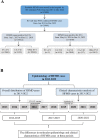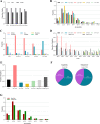Molecular epidemiology and clinical characteristics of enteroviruses associated HFMD in Chengdu, China, 2013-2022
- PMID: 37661256
- PMCID: PMC10476316
- DOI: 10.1186/s12985-023-02169-x
Molecular epidemiology and clinical characteristics of enteroviruses associated HFMD in Chengdu, China, 2013-2022
Abstract
Objectives: This study aims to investigate molecular epidemiology and clinical characteristics of enterovirus associated hand-foot-mouth disease (HFMD) in Chengdu, China, 2013-2022. Monitoring the molecular epidemiology and clinical features of HFMD for up to 10 years may provide some ideas for future protection and control measures.
Methods: We conducted a retrospective analysis of the medical records of all patients with laboratory-confirmed HFMD-related enterovirus infection at the West China Second University Hospital from January 2013 to December 2022. We described the characteristics in serotype, age, sex distribution and hospitalization of enterovirus infection cases using data analysis and graphic description.
Results: A total of 29,861 laboratory-confirmed cases of HFMD-related enterovirus infection were reported from 2013 to 2022. There was a significant reduction in the number and proportion of EV-A71 cases after 2016, from 1713 cases (13.60%) in 2013-2015 to 150 cases (1.83%) in 2017-2019. During the COVID-19 pandemic, EV-A71 cases even disappeared. The proportion of CV-A16 cases decreased from 13.96% in 2013-2015 to 10.84% in 2017-2019 and then to 4.54% in 2020-2022. Other (non-EV-A71 and non-CV-A16) serotypes accounted for 95.45% during 2020-2022, with CV-A6 accounting for 50.39% and CV-A10 accounting for 10.81%. Thus, CV-A6 and CV-A10 became the main prevalent serotypes. Furthermore, There was no significant difference in the enterovirus prevalence rate between males and females. The hospitalization rate of EV-A71 patients was higher that of other serotypes. In general, the proportion of HFMD hospitalizations caused by other pathogens except for EV-A71, CV-A16, CV-A10 and CV-A16 was second only to that caused by EV-A71. The proportion of children over 4 years old infected with enterovirus increased.
Conclusion: The incidence of HFMD associated with enterovirus infection has decreased significantly and CV-A6 has been the main pathogen of HFMD in Chengdu area in recent years. The potential for additional hospitalizations for other untested enterovirus serotypes suggested that attention should also be paid to the harms of infections with unknown enterovirus serotypes. Children with HFMD were older. The development of new diagnostic reagents and vaccines may play an important role in the prevention and control of enterovirus infection.
Keywords: Change; Clinical characteristics; Enterovirus; Epidemiology; HFMD.
© 2023. BioMed Central Ltd., part of Springer Nature.
Conflict of interest statement
The authors declare that the research was conducted in the absence of any commercial or financial relationships that could be construed as a potential conflict of interest.
Figures



Similar articles
-
[Clinical analysis of 555 outpatients with hand, foot and mouth diseases caused by different enteroviruses].Zhonghua Er Ke Za Zhi. 2019 Jun 2;57(6):445-451. doi: 10.3760/cma.j.issn.0578-1310.2019.06.009. Zhonghua Er Ke Za Zhi. 2019. PMID: 31216802 Chinese.
-
Molecular epidemiology and clinical features of hand, foot and mouth disease requiring hospitalization after the use of enterovirus A71 inactivated vaccine in chengdu, China, 2017-2022: a descriptive study.Emerg Microbes Infect. 2022 Dec;11(1):2510-2519. doi: 10.1080/22221751.2022.2125346. Emerg Microbes Infect. 2022. PMID: 36103331 Free PMC article.
-
Hand, Foot, and Mouth Disease in China: Modeling Epidemic Dynamics of Enterovirus Serotypes and Implications for Vaccination.PLoS Med. 2016 Feb 16;13(2):e1001958. doi: 10.1371/journal.pmed.1001958. eCollection 2016 Feb. PLoS Med. 2016. PMID: 26882540 Free PMC article.
-
EV-A71 vaccine licensure: a first step for multivalent enterovirus vaccine to control HFMD and other severe diseases.Emerg Microbes Infect. 2016 Jul 20;5(7):e75. doi: 10.1038/emi.2016.73. Emerg Microbes Infect. 2016. PMID: 27436364 Free PMC article. Review.
-
Hand, foot, and mouth disease associated with coxsackievirus A10: more serious than it seems.Expert Rev Anti Infect Ther. 2019 Apr;17(4):233-242. doi: 10.1080/14787210.2019.1585242. Epub 2019 Mar 6. Expert Rev Anti Infect Ther. 2019. PMID: 30793637 Review.
Cited by
-
Single nucleotide polymorphism of Notch1 gene rs3124599 allele is associated with the severity of CVA6-related HFMD in the Chinese Han population.BMC Infect Dis. 2024 Jul 29;24(1):750. doi: 10.1186/s12879-024-09640-2. BMC Infect Dis. 2024. PMID: 39075371 Free PMC article.
-
A review of the recombination events, mechanisms and consequences of Coxsackievirus A6.Infect Med (Beijing). 2024 May 1;3(2):100115. doi: 10.1016/j.imj.2024.100115. eCollection 2024 Jun. Infect Med (Beijing). 2024. PMID: 38974347 Free PMC article. Review.
-
Epidemiological characteristics of 5838 cases of enterovirus infection in children in Hangzhou from 2018 to 2023.Sci Rep. 2025 Mar 24;15(1):10167. doi: 10.1038/s41598-025-94883-5. Sci Rep. 2025. PMID: 40128330 Free PMC article.
-
Enterovirus Detection Trends Based on Respiratory Specimens from a Single Tertiary Hospital in Korea (2018-2024): A Retrospective Study Using Multiplex PCR Data.Viruses. 2025 Jul 16;17(7):991. doi: 10.3390/v17070991. Viruses. 2025. PMID: 40733608 Free PMC article.
-
Epidemiological, etiological, and serological characteristics of hand, foot, and mouth disease in Guizhou Province, Southwest China, from 2008 to 2023.PLoS Negl Trop Dis. 2025 Aug 18;19(8):e0013394. doi: 10.1371/journal.pntd.0013394. eCollection 2025 Aug. PLoS Negl Trop Dis. 2025. PMID: 40825065 Free PMC article.
References
-
- Li XW, Ni X, Qian SY, Wang Q, Jiang RM, Xu WB, Zhang YC, Yu GJ, Chen Q, Shang YX, Zhao CS, Yu H, Zhang T, Liu G, Deng HL, Gao J, Ran XG, Yang QZ, Xu BL, Huang XY, Wu XD, Bao YX, Chen YP, Chen ZH, Liu QQ, Lu GP, Liu CF, Wang RB, Zhang GL, Gu F, Xu HM, Li Y, Yang T. Chinese guidelines for the diagnosis and treatment of hand, foot and mouth disease (2018 edition) World J Pediatr. 2018;14:437–447. doi: 10.1007/s12519-018-0189-8. - DOI - PubMed
-
- Yi Z, Pei S, Suo W, Wang X, Huang Z, Yi A, Wang B, He Z, Wang R, Li Y, Fan W, Huang X. Epidemiological characteristics, routine laboratory diagnosis, clinical signs and risk factors for hand, -foot -and -mouth disease: a systematic review and meta-analysis. PLoS ONE. 2022;17:e0267716. doi: 10.1371/journal.pone.0267716. - DOI - PMC - PubMed
Publication types
MeSH terms
Substances
LinkOut - more resources
Full Text Sources
Medical

